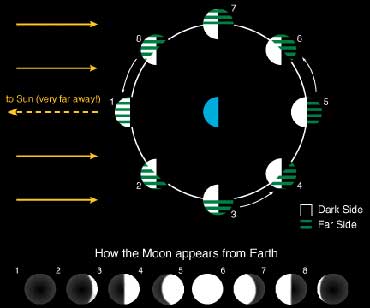Source: NASA
10-19-2007 11:37
 |
As the moon orbits Earth, an observer on Earth can see the moon appear to change shape. It seems to change from a crescent to a circle and back again. The shape looks different from one day to the next because the observer sees different parts of the moon's sunlit surface as the moon orbits Earth. The different appearances are known as the phases of the moon. The moon goes through a complete cycle of phases in a synodic month.
The moon has four phases: (1) new moon, (2) first quarter, (3) full moon, and (4) last quarter. When the moon is between the sun and Earth, its sunlit side is turned away from Earth. Astronomers call this darkened phase a new moon.
The next night after a new moon, a thin crescent of light appears along the moon's eastern edge. The remaining portion of the moon that faces Earth is faintly visible because of earthshine, sunlight reflected from Earth to the moon. Each night, an observer on Earth can see more of the sunlit side as the terminator, the line between sunlight and dark, moves westward. After about seven days, the observer can see half a full moon, commonly called a half moon. This phase is known as the first quarter because it occurs one quarter of the way through the synodic month. About seven days later, the moon is on the side of Earth opposite the sun. The entire sunlit side of the moon is now visible. This phase is called a full moon.
About seven days after a full moon, the observer again sees a half moon. This phase is the last quarter, or third quarter. After another seven days, the moon is between Earth and the sun, and another new moon occurs.
As the moon changes from new moon to full moon, and more and more of it becomes visible, it is said to be waxing. As it changes from full moon to new moon, and less and less of it can be seen, it is waning. When the moon appears smaller than a half moon, it is called crescent. When it looks larger than a half moon, but is not yet a full moon, it is called gibbous (GIHB uhs).
Like the sun, the moon rises in the east and sets in the west. As the moon progresses through its phases, it rises and sets at different times. In the new moon phase, it rises with the sun and travels close to the sun across the sky. Each successive day, the moon rises an average of about 50 minutes later.
Eclipses occur when Earth, the sun, and the moon are in a straight line, or nearly so. A lunar eclipse occurs when Earth gets directly -- or almost directly -- between the sun and the moon, and Earth's shadow falls on the moon. A lunar eclipse can occur only during a full moon. A solar eclipse occurs when the moon gets directly -- or almost directly -- between the sun and Earth, and the moon's shadow falls on Earth. A solar eclipse can occur only during a new moon.
During one part of each lunar orbit, Earth is between the sun and the moon; and, during another part of the orbit, the moon is between the sun and Earth. But in most cases, the astronomical bodies are not aligned directly enough to cause an eclipse. Instead, Earth casts its shadow into space above or below the moon, or the moon casts its shadow into space above or below Earth. The shadows extend into space in that way because the moon's orbit is tilted about 5 degrees relative to Earth's orbit around the sun.
Editor:Yang Jie
